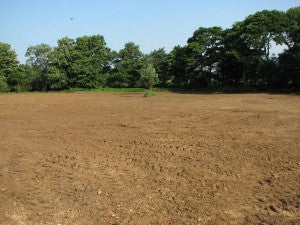
How To Make a Wildflower Meadow: Part Two
Share
Wildflower Meadowmaking Part Two
So now you’ve done everything we recommended in part one of how to make a wildflower meadow. You have sown your seed/planted plugs/laid wildflower turf. Whichever tactic you’re using, there are two super-mission-critical guidelines to follow when establishing and managing your meadow area. One: if in doubt, use common sense; ask yourself what happens in nature and mimic it. Two: don't prevaricate.

A Quick Recap - If You're Using Seed
After you've done your preparation, you will have sown/planted. AFTER YOU'VE DONE YOUR PREPARATION. You'll have chosen appropriate species to use, as per Part One, but let's have a bit of a recap.
“Appropriate” means appropriate for what you want out of them as well as their appropriateness for the geology and characteristics of your site. “Appropriate” also means carefully sourced British native plants. Most folk buy pre-determined seed mixes, which have been put together from individually sourced species, or they buy mixes with variable content which have been direct harvested from donor sites, like our Dorset seed mixes. I'm increasingly thinking this is the way to go. For specialised or large scale projects we're often asked for bespoke mixes which have been put together by landscapers or ecologists. If you're not going to source your plugs or seeds through us, source them through a supplier whose plants are locally and ethically sourced.
There's no kite mark in the wildflower plant business - I wish there was - so this is the only real guideline you've got. As you can imagine, the extra cost of small scale production means it's not the cheapest thing in the world, but often buying cheaper mass produced seed is a false economy as germination rates can be much lower - if it hasn't been freshly harvested, for example. What's worse is that these mixes often include non-native plants and can look a real mess.

Ready To Go
If you've seeded your meadow you will notice some seedlings will put on an impressive sprint, but please please remember that almost no perennial will flower in its first year of establishment. Some won't even germinate! It’s an enormous disappointment to many punters that their wildflower meadow looks so green and/or barren to begin with. They just notice a few blades of grass. In a sense, the less growth there is initially the better if it means poor fertility soil. This will lead to more diversity.
If you want colour, add some annuals into the original mix so you can get vibrant blues, reds and purples tout suite. Most meadow seed mixes do include one annual - Yellow Rattle – a bit of a star whose merits I discuss elsewhere.
If you're planting plugs it's pretty straightforward; again, just make sure plug plants don't have to compete with grass when they are getting established. We recommend 5 per square metre.
Whether you're using seed or plug plants, don't let them dry out. As the weather gets less reliable this is becoming more and more important, particularly when seeding / planting in spring.

Initial Maintenance
Whether you’re sowing / planting in autumn or spring, you can slip into your annual maintenance regime straight away. Traditionally meadows were cut as soon as the Rattle went to seed in midsummer. Although this will give you nice hay, most of our clients are more concerned with the look and/or ecological value of their meadow areas. If you are, ideally, cut in sections from the end of July until early September. If you can only give it one go, wait until mid August. The odd Knapweed will still be in flower.
Whenever you do cut it, and whatever you cut it with – scythe, topper, automatic scythe, lawnmower set to its highest level – you must take the hay off. It’s the easiest way of reducing soil fertility, which is a constant battle – less fertility, more flowers, fewer weeds and less aggressive grasses. You can use the hay to seed different areas too, by just spreading it around on the bare soil.
Over the winter keep your wildflower meadow tidy; if you’ve got sheep they’re the perfect lawnmowers. Otherwise, mow every month or so.
Obviously, leave it to grow again from early spring, when things are starting to stir. It does pay, though, to establish paths through your meadow area even if it’s not a thoroughfare – if you’re anything like me you’ll want to mooch about it of a summer’s evening getting a close up view of what’s going on. They will also make your meadow look like more of a deliberate feature.
However careful you are and however poor you soil is you WILL have problems with perennial weeds. I know one man’s weeds are another’s wildflowers, but dock, nettle and thistles are very invasive, whatever their merits, and I wander around during the summer hoicking them out. Assuming the soil isn't too fertile they will give up the ghost soon enough IF you weed them out BEFORE they set seed!
If grasses start to dominate the wildflower meadow, add more Rattle in the autumn. If new plant species start appearing over time, excellent. Your meadow won’t just change colour during the seasons, it will develop as it adapts to the local environment.




